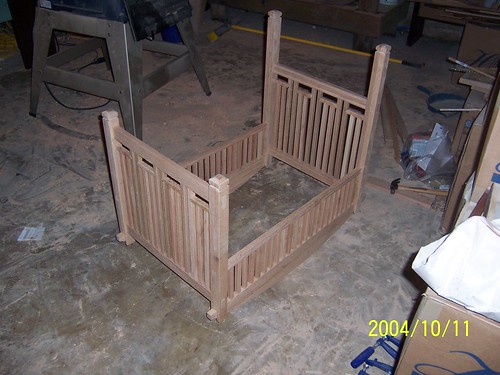Korean Furniture Blogging
Have I ever mentioned that my other Korea interest is building Korean furniture (redesigned according to my wife’s specs and my tastes)?
Been meaning to show some pictures of the cradle I built for my baby daughter for some time. She turns one next week, and as luck would have it, this kid is the one that eats, and she’s already outgrown it. I’d show you the completed version, but it’s full of laundry (sigh). At least my wife is using it for something.

Note ultra-strong mortise and tenon joints, which are the real deal. Material is white oak–actually, leftover flooring. If you could see the completed version, btw, it has a very cool and very usable set of retractable wheels underneath, so you can wheel the kid around or rock her to sleep. While the rocking didn’t prove very popular with our colicky baby, the wheels were a huge hit with both kids, who love being wheeled up and down the hallway.
Lesson: Build “˜em big enough for the kids to grow into. Also: add wheels.
My current project is two of these (or perhaps like this, or this), but with box joints, which are very difficult to cut, especially for the hexagonal shape, but beautiful and strong when done right (and I got them to fit perfectly, as you’ll eventually see). Korean cabinetmakers do sometimes use box joints, but primarily for benches and smaller cabinets. If you have any interest, I’ll put up some pix of the coffee table my wife and I built, modeled on the wooden lattice doors on Korean Buddhist temples.
If you live in Seoul and share an interest in traditional Korean furniture, skip Insadong and go here (Tapshimni Station)–it’s one of Seoul’s must-sees and probably your best value in Seoul for traditional Korean art and furniture. Surprisingly enough, the “Japanese side” of Itaewon has some excellent shops, too. The North Korean furniture has a very distinctive style with big, shiny, engraved rectangular white-metal hardware, which I love but which my wife and some South Koreans don’t. Ask the shop owner for “Pyongyang style.” For lattices, I love the ones at Kyongbukkung Palace. I’m also a fan of the triangular one on the gates of Tapkol Park. It’s almost impossible to appreciate how difficult those are to build until you it try it yourself. Update: If the measurements are off by more than 1/64th of an inch, they’ll be skewed and rickety. I built two semi-complex ones that came out nicely, but without the routed edges.
The Ho-Am Arts Center also had a superb exhibition on Chosun Dynasty furniture just days before my PCS from Korea, and a book of photos from the exhibit is still one of my favorites. The book indicates that some of the pieces are from Ewha Women’s University, so I expect they have some on display there, too.